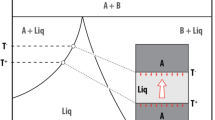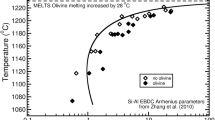Abstract
Compositional zoning of plagioclase is useful as a recorder of dynamic geological conditions if the mechanisms of crystal growth are known. Although the present lack of quantitative information on specific kinetic processes limits their accuracy, numerical simulations of phenoycryst plagioclase growth are useful both for identifying the most influential kinetic processes (for example, diffusion) that should receive priority in experimental measurements and for designing informative growth experiments. The interaction of kinetic processes at a crystal face is so complex that the overall result cannot be assessed intuitively. A primary purpose of these papers is to explore this interaction in the plagioclase system as quantitatively as data permit.
The growth of a single face of a plagioclase crystal in an infinite melt was simulated in computer models for: (1) anhydrous and hydrous plagioclase melts; (2) for different undercoolings; and (3) for both interface-controlled and melt-transport controlled growth. Major uncertainties include the velocity and nonequilibrium partitioning laws in the interface-controlled model, and transport coefficients for melt components. Comparison of computed models with published growth velocity data for anhydrous melts was used to estimate a transport coefficient (with the form for diffusion), and that coefficient was extrapolated to hydrous melts on the basis of the Stokes-Einstein relationship.
The results of simulations suggest that undercoolings reasonable for plutonic systems could result in deviations of crystal composition from that in equilibrium with the melt of several mole % An; geothermometers based on the assumption of equilibrium partitioning will be in error significantly. Similarly, the volatile content and composition of melt trapped during growth would deviate significantly from bulk melt properties. The velocity of crystal growth and deviation of crystal composition from equilibrium show low sensitivity to water content because larger water contents result in greater accumulation of water at the interface and a consequent depression of effective undercooling.
The large magnitude of the derived transport parameter suggests that local convection as well as diffusion may occur during growth in the anhydrous system. The addition of water to the system reduces viscosity and increases the density gradients near the crystal, making local convection even more probable. Our meagre knowledge of transport by diffusion and convection in the melt is probably the most important factor limiting the accuracy of growth simulations.
Similar content being viewed by others
References
Bottinga Y, Kudo A, Weill D (1966) Some observations on oscillatory zoning and crystallization of magmatic plagioclase. Am Mineral 51:792–806
Bottinga Y, Weill DF (1972) The viscosity of magmatic silicate liquids: A model for calculation. Am J Sci 272:438–475
Burnham CW (1975) Thermodynamics of melting in experimental silicate-volatile systems. Fortschr Mineral 52:101–118
Burnham CW (1979) The importance of volatile constituents. In: HS Yoder (ed) A Fiftieth Anniversary Appraisal of Bowen's Evolution of the Igneous Rocks. Princeton Univ
Cahn JW (1967) On the morphological stability of growing crystals. In: HS Peiser (ed) Crystal Growth. Pergamon, Oxford
Carnahan B, Luther HA, Wilkes JO (1969) Applied Numerical Methods. New York: John Wiley & Sons
Donaldson CH (1975) Calculated diffusion coefficients and the growth rate of olivine in a basalt magma. Lithos 8:163–174
Dowty E (1977) The importance of absorption in igneous partitioning of trace elements. Geochim Cosmochim Acta 41:1643–1646
Eagan RJ, Bergeron CG (1972) Effect of melt composition on the crystal growth kinetics of PbB4O7. In: LL Hench, SW Freiman (eds) Advances in Nucleation and Crystallization in Glasses. Am Ceram Soc, Spec Publ 5, pp 191–201, Cleveland
Fenn PM (1977) Nucleation and growth of alkali feldspar from hydrous melts. Canad Mineral 15:135–161
Flood H, Knapp WJ (1968) Structural characteristics of liquid mixtures of feldspar and silica. J Am Ceram Soc 51:259–263
Harloff C (1927) Zonal structure in plagioclase. Leidsche Geol Mededeel 2:99–114
Hess PC (1970) Polymer model of silicate melts. Geochim Cosmochim Acta 35:289–306
Hopper RW, Uhlmann DR (1974) Solute redistribution during crystallization at constant velocity and constant temperature. J Crystal Growth 21:203–213
Jambon A (1979) Diffusion of water in obsidian. EOS 60:409 (abstr)
Johannes W (1978) Melting of plagioclase in the system Ab-An-H2O and Qz-Ab-An-H2O at \(P_{{\text{H}}_{\text{2}} {\text{O}}} \)=5 kbars, an equilibrium problem. Contrib Mineral Petrol 66:295–304
Kirkpatrick RJ (1975) Crystal growth from the melt: A review. Am Mineral 60:798–814
Kirkpatrick RJ, Robinson GR, Hays JF (1976) Kinetics of crystal growth from silicate melts: Anorthite and diopside. J Geophys Res 81:5715–5720
Kirkpatrick RJ, Klein L, Uhlmann DR, Hays JF (1979) Rates and processes of crystal growth in the system anorthite-albite. J Geophys Res 84:3671–3676
Lofgren G (1972) Temperature induced zoning in synthetic plagioclase feldspar: In: WS MacKenzie (ed) The Feldspars, pp 362–377, Manchester
Loomis TP (1978a) Multicomponent diffusion in garnet I. Formulation of isothermal models. Am J Sci 278:1099–1118
Loomis TP (1978b) Multicomponent diffusion in garnet II. Comparison of models with natural data. Am J Sci 278:1119–1137
Loomis TP (1979) An empirical model for plagioclase equilibrium in hydrous melts. Geochim Cosmochim Acta 43:1753–1759
Margaritz M, Hofmann AW (1978) Diffusion of Sr, Ba and Na in obsidian. Geochim Cosmochim Acta 42:595–606
O'Hara J, Tarshis LA, Tiller WA, Hunt JP (1968) Discussion of interface stability of large facets on solution grown crystals. J Crystal Growth 3–4:555–561
Ralston A (1965) A First Course in Numerical Analysis. New York: McGraw-Hill
Rutter JW, Chalmers B (1953) A prismatic substructure formed during the solidification of metals. Can J Phys 31:15–39
Shaw HR (1972) Viscosities of magmatic silicate liquids. An empirical method of prediction. Am J Sci 272:870–893
Shaw HR (1974) Diffusion of H2O in granitic liquids: In: AW Hofmann, BJ Giletti HS, Yoder Jr, RA Yund (eds) Geochemical Transport and Kinetics, pp 139–170, Carnegic Inst Wash, Publ 634
Sibley DF, Vogel TA, Walker BW, Byerly G (1976) The origin of oscillatory zoning in plagioclase: A diffusion and growth controlled model. Am J Sci 276:275–284
Smith VG, Tiller WA, Rutter JW (1955) A mathematical analysis of solute redistribution during solidification. Can J Phys 33:723–745
Swanson SE (1977) Relation of nucleation and crystal-growth rate to the development of granitic textures. Am Mineral 62:966–978
Tarshis LA, Tiller WA (1967) The effect of interface attachment kinetics on the morphological stability of a planar interface during solidification. In: HS Peiser (ed) Crystal Growth, pp 709–719, Pergamon, Oxford
Taylor M, Brown GE Jr (1979) Structure of mineral glasses — I. The feldspar glasses NaAlSi3O8, KAlSi3O8, CaAl2Si2O8. Geochim Cosmochim Acta 43:61–76
Vance JA (1962) Zoning in igneous plagioclase: Normal and oscillatory zoning. Am J Sci 260:756–760
Winchell P (1969) The compensation law for diffusion in silicates. High Temp Sci 1:200–215
Author information
Authors and Affiliations
Rights and permissions
About this article
Cite this article
Loomis, T.P. An investigation of disequilibrium growth processes of plagioclase in the system anorthite-albite-water by methods of numerical simulation. Contr. Mineral. and Petrol. 76, 196–205 (1981). https://doi.org/10.1007/BF00371959
Received:
Accepted:
Issue Date:
DOI: https://doi.org/10.1007/BF00371959




